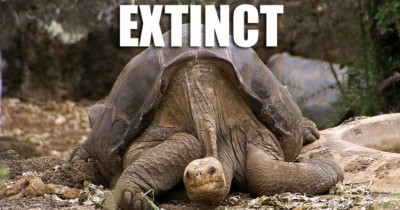Extinction of Animal Life on Planet Earth. Exceptional Loss of Biodiversity

Update 6/22/2015: On Friday, a study published by experts from Stanford, Princeton and the University of California-Berkeley declared the world’s vertebrates are going extinct 114 times faster than the natural rate of extinction, according to the Huffington Post.
The researchers write that “these estimates reveal an exceptionally rapid loss of biodiversity over the last few centuries, indicating that a sixth mass extinction is already under way.”
Last year, we published the following list of every animal that went extinct in the last century. Updating it today to highlight the most recent study and news that the U.S. Fish and Wildlife service have declared the eastern cougar extinct. And we’re dangerously close to losing 13 more animal species.
Take a look at our post from last year, and keep in mind the words of the study’s lead author, Gerardo Ceballos: “If it is allowed to continue, life would take many millions of years to recover and our species itself would likely disappear early on:”
The number of extinct animals is difficult to calculate and always higher than the estimate. In some cases, a species is presumed extinct — none have been seen in years — but it’s yet to receive official extinction status by the IUCN. But the important thing to remember is that extinction is not a historical problem — it’s a contemporary issue.
Below, take a look at every animal (except insects, which are extremely difficult to catalogue but which you can find here) that went extinct in just the last 100 years.
The list is based on research provided by the Sixth Extinction, a website created to “enhance free public access to information about recently extinct species,” and in order of their approximate date of extinction. We’ve included all the animals confirmed extinct by the IUCN, and added a few more declared extinct by other credible individuals and organizations.
We hope this list helps you reflect on the color, diversity and magnificence of life in our world, and especially our oceans. As well as how much more colorful and diverse it might be if we took better care of natural habitats.
*Where we could not picture the exact animal, we’ve put the species name in gray text and provided an image of a closely related species.
2015 — Eastern Cougar, Puma Concolor Couguar
(Source: Wikimedia)
2013 – Formosan Clouded Leopard, Neofelis nebulosa brachyura

(Source: “LeopardusBrachyurusWolf” by Joseph Wolf)
2012 — Pinta Island Tortoise, Chelonoidis abingdoni

(Source: Flickr/Putneymark)
2011 — Vietnamese Rhino, Rhinoceros sondaicus annamiticus

This is the Javan rhino, rhinoceros sondaicus sondaicus, a very similar subspecies to the extinct Vietnamese rhino.
2009 — Christmas Island Pipistrelle, Pipistrellus murrayi

(Source: Hfc-hersfield.de)
2007 — Chinese Paddlefish, Psephurus gladius

(Source: “Psephurus gladius” by Muséum d’histoire Naturelle)
2007 — Yangtze River Dolphin, Lipotes vexillifer

(Source: “Lipotes vexillifer” by Alessio Marrucci)
2004 — Po’o-uli, Melamprosops phaeosoma

(Source: “Poʻouli” by U.S. Fish and Wildlife Service)
2002 — Vine Raiatea Tree Snail, Partula labrusca

(Source: Islandbiodiversity)
To Read Complete Article (with photos) click below
http://www.pixable.com/article/heres-every-single-animal-that-became-extinct-in-the-last-100-years-photos-67674/


